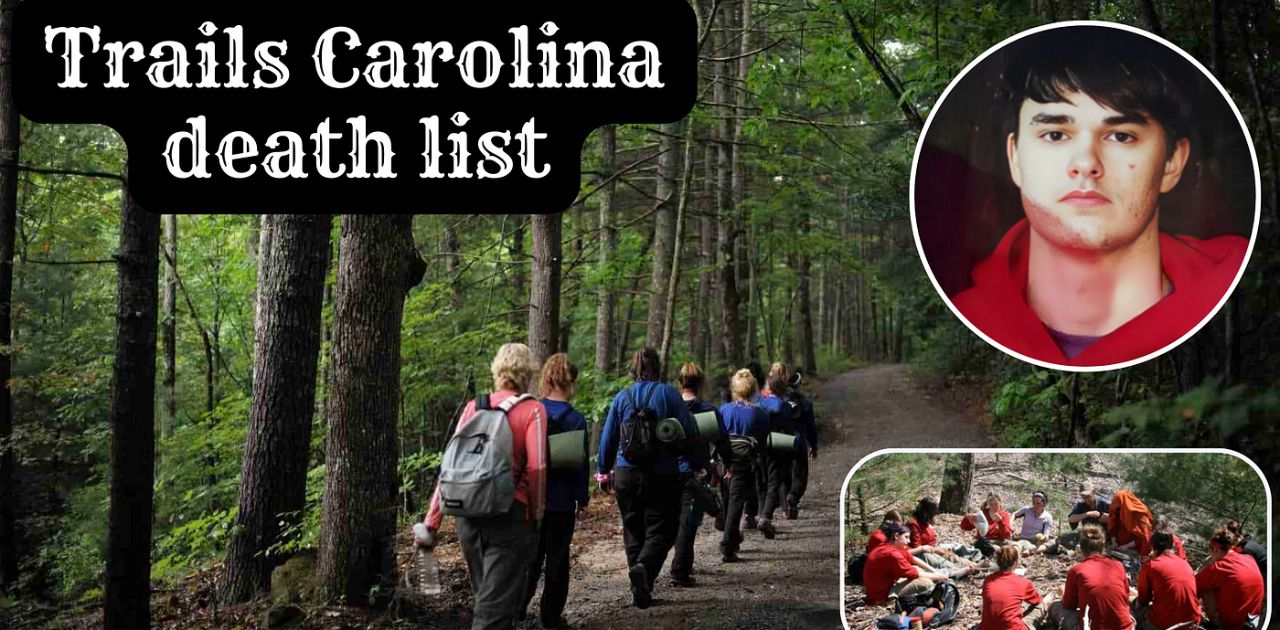Trails Carolina, a wilderness therapy program designed to help troubled youth through outdoor activities, education, and therapy, has come under intense scrutiny following a series of tragic incidents.
Since 2018, at least three teenagers have died while under the program’s care, raising serious concerns about its safety protocols and the overall well-being of its participants.
These fatalities have prompted a wider conversation about the effectiveness and regulation of wilderness therapy programs, highlighting the urgent need for reform and greater oversight to ensure the safety and mental health of the young individuals they aim to support.
What Is Trails Carolina Death List?
Trails Carolina, a wilderness therapy program based in the mountains of North Carolina, aims to assist troubled youth through a combination of outdoor adventures, education, and therapeutic interventions.
Despite its noble intentions, the program has been marred by several tragic incidents, leading to the unfortunate creation of what is referred to as the “Trails Carolina Death List.” This list encompasses the names and stories of participants who have lost their lives while enrolled in the program, raising significant concerns about the safety and efficacy of wilderness therapy.
The Trails Carolina Death List is not an official document but a term used by critics and concerned parties to highlight the fatalities that have occurred. These tragic events have sparked widespread debate about the risks associated with wilderness therapy programs and the adequacy of their safety protocols. Parents, former participants, and advocacy groups have called for greater transparency, better regulation, and more robust safety measures to prevent further tragedies.
The Unfortunate Events At Trails Carolina
Trails Carolina’s approach to helping troubled youth involves taking them out of their familiar environments and placing them in nature to foster personal growth and resilience. However, this method has not been without its challenges. Several incidents have raised serious questions about the program’s ability to ensure the safety and well-being of its participants.
One of the most notable incidents occurred in 2014, when Alec Lansing, a 17-year-old participant, died during a camping trip. This tragedy brought national attention to the risks involved in wilderness therapy. Alec’s death, along with other incidents, has led to increased scrutiny of Trails Carolina and similar programs.
The program has faced multiple accusations of mistreatment and neglect. Former participants and employees have reported instances of emotional manipulation, physical restraint, and a lack of transparency regarding safety protocols. These allegations, coupled with the fatalities, have cast a shadow over the program’s reputation and raised doubts about its commitment to participant safety.
Alec Lansing’s Death

Alec Lansing’s death in 2014 is perhaps the most significant and tragic event associated with Trails Carolina. Alec was participating in a camping trip in the Nantahala National Forest when he became separated from his group. Despite an extensive search effort involving the Jackson County Sheriff’s Office, Alec was found dead from hypothermia.
The circumstances surrounding Alec’s death have raised critical questions about the program’s safety protocols and emergency preparedness. Alec’s family and friends were devastated by his loss, and the incident prompted a state investigation into Trails Carolina’s operations.
The investigation revealed several violations, including inadequate staff training and insufficient emergency preparedness. These findings highlighted systemic issues within the program and underscored the need for comprehensive reform to prevent similar tragedies in the future. Alec’s death remains a poignant reminder of the potential dangers of wilderness therapy and the importance of stringent safety measures.
Katelyn Haruko
Katelyn Haruko’s story, though not directly linked to Trails Carolina, is often mentioned in discussions about the risks of wilderness therapy programs. Katelyn grew up in a tough neighborhood and faced numerous challenges, including involvement with drugs and gangs. Her participation in a wilderness therapy program marked a turning point in her life, offering her a chance to escape her troubled past and find peace in nature.
During her time in the program, Katelyn fully embraced the therapeutic experience. She spent time in the Utah desert with a group of peers, enduring harsh conditions with limited resources. Despite these challenges, Katelyn found solace and began to turn her life around.
Katelyn’s story highlights the potential benefits of wilderness therapy for some participants. However, it also underscores the importance of adequate support and safety measures to ensure that all participants can safely navigate the challenges of the wilderness. Katelyn’s positive transformation serves as a testament to the potential of these programs, while also reminding us of the need for careful oversight and regulation.
Sergey Blashchishen
Sergey Blashchishen, a 16-year-old from Parkrose, Oregon, tragically lost his life during a hiking trip organized by the SageWalk Wilderness School. Sergey’s death, caused by heat stroke, is being investigated as a potential homicide, drawing attention to the serious risks associated with wilderness therapy programs.
During the hike, Sergey collapsed from exhaustion and eventually died after experiencing severe symptoms, including vomiting blood. His death highlights the critical importance of proper medical care, adequate hydration, and nutrition during wilderness therapy activities.
The investigation into Sergey’s death has focused on the adequacy of care provided by the program’s staff. Allegations have surfaced that Sergey’s concerns about his health were dismissed by staff members, raising questions about their responsiveness to medical emergencies. This case underscores the need for stringent health and safety protocols in wilderness therapy programs to prevent such tragic outcomes.
Caleb Jensen
Caleb Jensen’s experience with Trails Carolina represents another tragic chapter in the history of wilderness therapy programs. Caleb, who had struggled with behavioral issues and spent time in juvenile detention, enrolled in Trails Carolina as part of his path to recovery. Unfortunately, his time in the program ended in tragedy when he died from an undetected staph infection.
Caleb’s story is a stark reminder of the potential dangers faced by participants in wilderness therapy programs. Despite his enthusiasm for outdoor activities and his efforts to turn his life around, Caleb’s pleas for help went unanswered. His death from a methicillin-resistant Staphylococcus aureus (MRSA) infection, which went untreated, raised serious concerns about the program’s medical oversight and emergency response protocols.
Caleb’s mother subsequently filed a lawsuit against the program, alleging negligence and inadequate medical care. This case has further fueled calls for better regulation and oversight of wilderness therapy programs to ensure that participants receive the medical attention they need and deserve.
Other Fatal Incidents at Trails Carolina
In addition to the high-profile cases of Alec Lansing and Caleb Jensen, Trails Carolina has been linked to other fatal incidents that have raised concerns about the safety of wilderness therapy programs. These incidents include the deaths of William Edward Lee, Ian August, and Charles Moody, all of whom died under tragic circumstances while enrolled in wilderness therapy programs.
William Edward Lee, a 15-year-old participant, suffered fatal head trauma in 2000. Ian August, a 14-year-old, died from heat exhaustion in 2002. Charles Moody, a 17-year-old, died from asphyxiation following a physical restraint in 2004. Each of these deaths underscores the potential risks associated with wilderness therapy and the need for rigorous safety measures and oversight.
These tragic incidents have prompted widespread calls for better regulation and monitoring of wilderness therapy programs to ensure the safety and well-being of participants. Critics argue that these programs often operate with insufficient oversight, allowing dangerous practices to continue unchecked.
Requirements for Inspection and Monitoring
The series of tragic incidents at Trails Carolina and similar programs have led to calls for more stringent inspection and monitoring requirements. Advocates argue that increased oversight is essential to ensure the safety and well-being of participants in wilderness therapy programs.
Regulatory bodies, such as the North Carolina Department of Health and Human Services (DHHS), have conducted investigations into Trails Carolina, revealing numerous violations. These investigations have highlighted deficiencies in staff training, emergency preparedness, and participant oversight. Despite these findings, critics contend that the current regulatory framework is insufficient to prevent further tragedies.
Proposed reforms include mandatory licensing for wilderness therapy programs, regular inspections, and the implementation of standardized safety protocols. Advocates also call for greater transparency, including the publication of incident reports and violation histories, to provide parents with the information they need to make informed decisions about enrolling their children in these programs.
Safety Protocols
In response to the tragic incidents and increased scrutiny, Trails Carolina and other wilderness therapy programs have been urged to strengthen their safety protocols. Ensuring the safety and well-being of participants is paramount, and robust safety measures are essential to prevent further tragedies.
Key areas for improvement include comprehensive staff training in emergency response and medical care, as well as the implementation of clear and effective safety protocols for outdoor activities. Programs must also establish rigorous screening processes to assess participants’ physical and mental health, ensuring that they are fit to participate in wilderness therapy.
Emergency preparedness is another critical area, requiring programs to develop and regularly update emergency response plans. These plans should include protocols for dealing with medical emergencies, weather-related hazards, and other potential risks. Ensuring that staff members are adequately trained and equipped to handle emergencies is essential to safeguarding the lives of participants.
The Psychological Impact on Adolescents
Wilderness therapy programs are designed to help adolescents struggling with behavioral and emotional issues. However, the psychological impact of these programs can be complex, with both positive and negative outcomes.
Proponents of wilderness therapy argue that the programs provide valuable opportunities for personal growth, resilience building, and emotional healing. By removing participants from their familiar environments and immersing them in nature, these programs aim to foster self-reflection, self-reliance, and improved mental health.
However, critics highlight the potential for negative psychological effects, particularly in programs with inadequate support and safety measures. Allegations of emotional manipulation, physical restraint, and neglect have raised concerns about the potential for trauma and psychological harm. Ensuring that participants receive individualized care and support from qualified mental health professionals is essential to mitigate these risks and promote positive outcomes.
The Direction of Travel
The tragic incidents and troubling allegations associated with Trails Carolina underscore the need for a comprehensive evaluation of wilderness therapy programs. Ensuring the safety and well-being of participants must be the top priority, and programs that fail to meet rigorous standards should face significant consequences.
Moving forward, it is essential for wilderness therapy programs to adopt best practices and adhere to strict safety protocols. This includes implementing robust staff training, emergency preparedness measures, and comprehensive support systems for participants. Greater transparency and accountability are also crucial, with programs required to provide clear and accurate information about their practices and outcomes.
For parents considering wilderness therapy for their children, conducting thorough research and exercising caution is vital. Reputable programs should have a proven track record of positive outcomes, transparent policies, and open communication with parents. By prioritizing safety and accountability, wilderness therapy programs can better serve the needs of troubled youth and help them achieve lasting positive change.
Overseeing Wilderness Therapy Camps
Effective oversight of wilderness therapy camps is essential to ensure the safety and well-being of participants. Regulatory bodies, such as state health departments and child welfare agencies, play a crucial role in monitoring these programs and enforcing compliance with safety standards.
To enhance oversight, regulatory agencies should conduct regular inspections of wilderness therapy camps, with a focus on assessing staff qualifications, safety protocols, and participant care. These inspections should be unannounced and comprehensive, ensuring that programs are held accountable for maintaining high standards of safety and care.
In addition to regulatory oversight, independent accreditation organizations, such as the Outdoor Behavioral Healthcare Council (OBH Council), can provide valuable guidance and certification for wilderness therapy programs. Accreditation from reputable organizations signals a commitment to best practices and continuous improvement, offering parents greater confidence in the quality and safety of the program.
Legal Claims Against Trails Carolina
The series of tragic incidents at Trails Carolina has led to numerous legal claims against the program, with families seeking justice and accountability for the deaths of their loved ones. These legal claims have highlighted significant concerns about the program’s safety protocols, staff training, and emergency preparedness.
In the case of Alec Lansing, his family filed a lawsuit against Trails Carolina, alleging negligence and inadequate safety measures. The lawsuit contended that Alec’s death could have been prevented if the program had implemented proper safety protocols and provided adequate supervision.
Similarly, Caleb Jensen’s family filed a lawsuit alleging that Trails Carolina failed to provide necessary medical care and neglected Caleb’s health needs. The legal claims against the program have underscored the importance of robust safety measures and accountability to prevent further tragedies and ensure justice for affected families.
Seeking Legal Redress For Accountability And Fairness
For families who have lost loved ones in wilderness therapy programs, seeking legal redress is a crucial step in holding programs accountable and achieving justice. Legal action can provide a pathway for families to obtain compensation for their loss, as well as prompt necessary reforms to prevent future tragedies.
When pursuing legal action, families typically seek the assistance of experienced attorneys specializing in personal injury and wrongful death cases. These attorneys can help families navigate the complex legal process, gather evidence, and build a strong case against the program.
In addition to legal action, families can advocate for regulatory reforms and increased oversight to improve the safety and accountability of wilderness therapy programs. By working together, affected families and advocacy groups can drive meaningful change and ensure that other families do not have to endure similar tragedies.
The Trails Carolina Wilderness Therapy Program: A Guide to the Advantages and Dangers
Wilderness therapy programs like Trails Carolina offer a unique approach to helping troubled youth through outdoor activities and therapeutic interventions. While these programs can provide valuable benefits, they also come with significant risks that must be carefully managed.
Advantages of wilderness therapy include the opportunity for personal growth, resilience building, and emotional healing. Participants can benefit from the structured environment, therapeutic activities, and support from trained professionals. For some, the experience can lead to lasting positive changes and improved mental health.
However, the dangers associated with wilderness therapy are also significant. The tragic incidents at Trails Carolina highlight the potential for serious harm, including medical emergencies, inadequate supervision, and neglect. Ensuring that programs adhere to stringent safety protocols and provide comprehensive support is essential to mitigate these risks.
Parents considering wilderness therapy for their children should thoroughly research potential programs, ask detailed questions about safety measures, and seek recommendations from trusted sources. By making informed decisions, parents can help ensure that their children receive the benefits of wilderness therapy while minimizing the associated risks.
Narratives of Obstacles at Trails Carolina: Impact on Public Perception
The tragic incidents and allegations of mistreatment at Trails Carolina have significantly impacted public perception of the program and wilderness therapy as a whole. Negative narratives, fueled by media coverage and personal accounts from former participants and their families, have raised serious doubts about the safety and efficacy of these programs.
Public perception has been shaped by high-profile cases like Alec Lansing and Caleb Jensen, as well as ongoing legal claims and regulatory investigations. These stories have highlighted the potential dangers of wilderness therapy and the need for rigorous oversight and accountability.
In response to these negative narratives, Trails Carolina and similar programs must work to rebuild trust with the public. This includes implementing comprehensive safety measures, ensuring transparency, and demonstrating a commitment to participant well-being. By addressing the concerns raised by critics and making meaningful improvements, wilderness therapy programs can help restore public confidence and demonstrate their value in supporting troubled youth.
What Reforms Are Required to Stop Tragedies
To prevent further tragedies in wilderness therapy programs, comprehensive reforms are essential. Key areas for improvement include enhanced safety protocols, increased regulatory oversight, and greater transparency and accountability.
Enhanced safety protocols should include comprehensive staff training, rigorous screening processes for participants, and robust emergency preparedness measures. Programs must ensure that staff members are adequately trained to handle medical emergencies and provide appropriate care and support to participants.
Increased regulatory oversight is also crucial, with regular inspections and strict enforcement of safety standards. Regulatory bodies must hold programs accountable for maintaining high standards of care and take swift action in response to violations.
Transparency and accountability are essential to rebuilding public trust and ensuring the safety of participants. Programs should provide clear and accurate information about their practices, outcomes, and incident histories, allowing parents to make informed decisions. Additionally, independent accreditation and certification can signal a commitment to best practices and continuous improvement.
Calls for Scrutiny and Regulation
The tragic incidents at Trails Carolina have prompted widespread calls for increased scrutiny and regulation of wilderness therapy programs. Advocates argue that greater oversight is essential to ensure the safety and well-being of participants and prevent further tragedies.
Regulatory bodies, such as state health departments and child welfare agencies, must play a proactive role in monitoring these programs and enforcing compliance with safety standards. This includes conducting regular inspections, investigating complaints, and taking appropriate action in response to violations.
In addition to regulatory oversight, independent accreditation organizations can provide valuable guidance and certification for wilderness therapy programs. Accreditation from reputable organizations signals a commitment to best practices and continuous improvement, offering parents greater confidence in the quality and safety of the program.
Ultimately, the goal of increased scrutiny and regulation is to create a safer and more accountable environment for participants in wilderness therapy programs. By addressing the systemic issues that have contributed to past tragedies, these programs can better serve the needs of troubled youth and help them achieve lasting positive change.
Conclusion
The tragic incidents and controversies surrounding Trails Carolina and other wilderness therapy programs underscore the critical need for comprehensive reforms to ensure the safety and well-being of participants.
The stories of Alec Lansing, Caleb Jensen, Sergey Blashchishen, and others serve as poignant reminders of the potential dangers inherent in these programs when proper safety protocols and oversight are not in place.
The creation of the “Trails Carolina Death List” highlights the serious risks and consequences associated with inadequate safety measures and emergency preparedness. These tragedies have fueled public concern, prompting calls for increased scrutiny, regulation, and accountability.
Ensuring the safety of participants requires a multifaceted approach, involving stringent safety protocols, comprehensive staff training, rigorous participant screening, and robust emergency response plans.
Read Also: Darlene Gayman Jennings Biography, Age, Wiki, Facts, Husband, Kids, Net Worth

Alexander Wren, a seasoned author with 8 years of expertise, excels in document assistance. His domain “docs help ful” showcases a legacy of user-friendly content, blending creativity and precision to simplify complexity.








